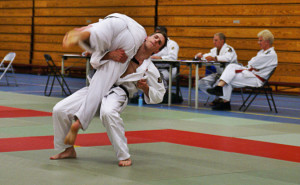Competition Rules: Important or Not?
Blog by Sebastiaan Fransen, 5th dan Judo
https://www.spfransen.nl/competitieregels-belangrijk-of-niet/
In recent years, there have been significant changes in competition rules, such as banning “leg grabbing” and eliminating minor scores. These adjustments aim to maintain Judo’s distinctive identity compared to other wrestling styles.
I often express criticism regarding competition rules. Some people question why I intervene, considering I am not actively competing myself. Allow me to clarify.
Difference Between Randori and Shiai
In my blog “Randori is Chaos,” I explained that randori isn’t a competition. It offers the freedom to practice techniques openly, contrasting with kata, which involves structured, predetermined forms.
Randori can occasionally resemble competition, yet its primary objective remains learning and development. Sometimes lower intensity is preferable. While shiai (competition) also promotes learning, practically speaking, many participants are motivated primarily by medals and recognition.
The Impact of Competition Rules
Rules significantly influence Judo practice:
Leg grabbing: Previously, a poorly executed leg-grab might score a koka or yuko, allowing judoka to tactically stall afterward. Currently, banning leg grabbing and minor scores forces judoka into executing proper throwing techniques, a positive development.
Ne-waza Time: Adjustments in groundwork time affect training priorities. Longer groundwork durations lead to increased ne-waza practice; shorter durations favor throwing techniques, resulting in defensive belly-down positions in competition.
Mate Situations: In Brazilian Jiu-Jitsu (BJJ), standing up during groundwork doesn’t lead to restarting from standing, unlike Judo’s “mate” call. This rule allows more effective standing guard-passing techniques, highlighting the extensive influence of rules.
Relationship Between Randori and Competition Rules
Competition rules heavily shape competition. Unfortunately, this influence extends into randori, making Judo narrower. Valuable and effective techniques fade from practice, and innovations from other martial arts and sports struggle to flourish within Judo.
Although randori theoretically could have completely different rules than shiai—focusing on safety and educational aspects—the reality is different. Competition rules from Judo Bond Nederland often dominate training, partly due to coaches fearing that judoka might otherwise apply prohibited techniques during competitions.
Consequently, Judo training loses diversity. Effective techniques diminish or vanish entirely. While techniques like kata-guruma and ashi-guruma remain in kata, will innovative variants of sukui-nage still appear in randori in the future?
How Can We Make Judo More Complete?
Initiatives like Freestyle Judo attempt to revert to older competition rules, integrating modern influences from BJJ. However, this approach merely shifts the influence rather than resolving the underlying issue.
Although there’s no perfect solution, these tips can help:
Train Effective Techniques: Practice techniques for effectiveness and educational value. Embrace beautiful throws like ko-uchi-maki-komi or kata-guruma, adapting them appropriately for competitive judoka and permitting their use in exams when performed safely.
Vary Randori Rules: Occasionally allow all techniques in randori, provided safety is ensured. Ensure judokas’ proficiency matches technique difficulty. Additionally, practicing randori in shorts and t-shirts can provide an engaging variation.
Cross-Training: Engage in other martial arts with different rules to enhance adaptability and improvisation. Personally, BJJ provides valuable insights into techniques effective against defensive, standing opponents and allows effective ground adaptations.
This summary presents my perspective and suggestions. I welcome other judokas’ views. Do readers have additional tips for preserving effective techniques? Share your thoughts in the comments.
